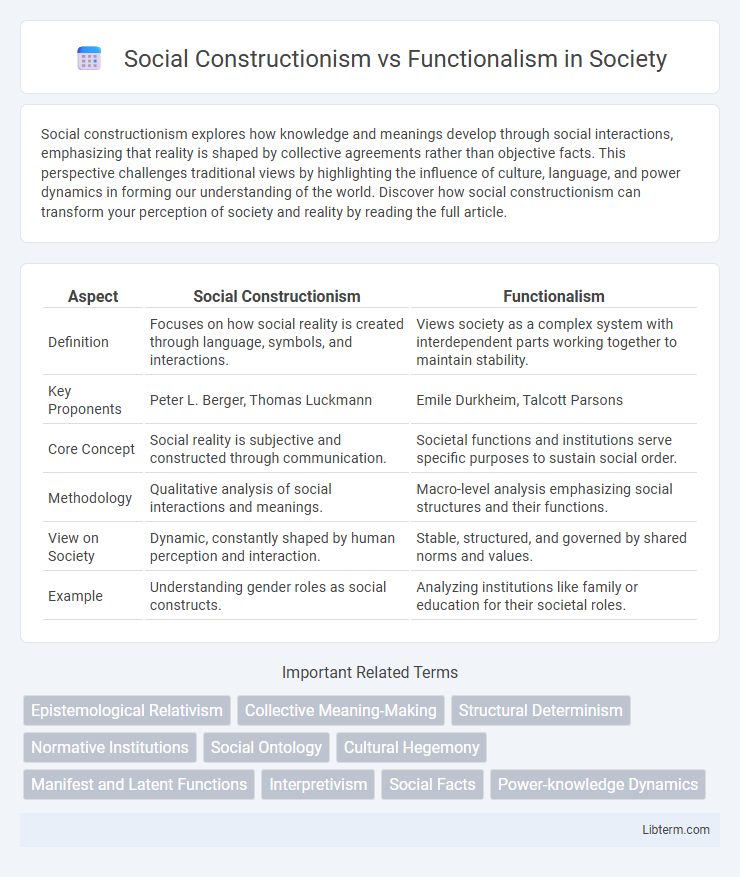Social constructionism explores how knowledge and meanings develop through social interactions, emphasizing that reality is shaped by collective agreements rather than objective facts. This perspective challenges traditional views by highlighting the influence of culture, language, and power dynamics in forming our understanding of the world. Discover how social constructionism can transform your perception of society and reality by reading the full article.
Table of Comparison
| Aspect | Social Constructionism | Functionalism |
|---|---|---|
| Definition | Focuses on how social reality is created through language, symbols, and interactions. | Views society as a complex system with interdependent parts working together to maintain stability. |
| Key Proponents | Peter L. Berger, Thomas Luckmann | Emile Durkheim, Talcott Parsons |
| Core Concept | Social reality is subjective and constructed through communication. | Societal functions and institutions serve specific purposes to sustain social order. |
| Methodology | Qualitative analysis of social interactions and meanings. | Macro-level analysis emphasizing social structures and their functions. |
| View on Society | Dynamic, constantly shaped by human perception and interaction. | Stable, structured, and governed by shared norms and values. |
| Example | Understanding gender roles as social constructs. | Analyzing institutions like family or education for their societal roles. |
Introduction to Social Constructionism and Functionalism
Social Constructionism emphasizes that social realities and knowledge are developed through collective human interactions, highlighting the subjective nature of understanding societal phenomena. Functionalism views society as a complex system whose parts work together to promote stability and social order, focusing on the roles of social institutions in maintaining equilibrium. Both perspectives provide critical frameworks for analyzing social structures, with Social Constructionism addressing the fluidity of meaning and Functionalism emphasizing systemic functionality.
Historical Background of Both Theories
Social constructionism emerged in the mid-20th century, rooted in the works of sociologists like Peter Berger and Thomas Luckmann, emphasizing how social realities are created through collective human interaction and language. Functionalism traces its origins to the 19th-century works of Emile Durkheim, who analyzed society as a complex system of interrelated parts functioning together to maintain stability and social order. Both theories developed as responses to understanding society but diverge in viewing social phenomena either as constructed meanings or as essential functions sustaining societal equilibrium.
Core Principles of Social Constructionism
Social Constructionism centers on the idea that knowledge, reality, and meaning are created through social interactions and shared beliefs rather than existing objectively. It emphasizes the role of language, culture, and interpersonal communication in shaping perceptions of identity, norms, and social institutions. This theory challenges the notion of fixed social facts by highlighting how social realities are continuously constructed and reconstructed through collective processes.
Key Concepts of Functionalism
Functionalism centers on key concepts such as social structures, social functions, and equilibrium, emphasizing the role each part of society plays in maintaining stability and cohesion. Social institutions like family, education, and religion serve essential functions that contribute to the smooth operation and integration of society. This perspective views society as an interconnected system where dysfunction in one area can disrupt overall harmony, underscoring the importance of social roles and norms.
Social Constructionism: Understanding Reality
Social Constructionism emphasizes that reality is shaped through social interactions and shared meanings rather than existing independently. It argues that knowledge and truth are products of collective agreements within a cultural context, highlighting how societal norms and language influence perceptions of reality. This perspective contrasts with Functionalism, which views social structures as objective entities that serve specific functions to maintain societal stability.
Functionalism: Analyzing Social Stability
Functionalism analyzes social stability by emphasizing the interdependence of societal institutions and their roles in maintaining order and cohesion. This perspective views society as a complex system where each part contributes to the overall stability and functionality, such as how education promotes socialization and economic institutions support resource distribution. By highlighting how norms, values, and institutions work together, functionalism explains how social stability is preserved and disruptions are minimized.
Major Differences Between Social Constructionism and Functionalism
Social Constructionism emphasizes the subjective creation of social realities through language, symbols, and interactions, highlighting how knowledge and meaning are socially constructed. Functionalism, in contrast, views society as a complex system with interrelated parts designed to maintain stability and social order by fulfilling essential functions. The major differences lie in Social Constructionism's focus on the fluid, dynamic creation of social norms and Functionalism's emphasis on structural stability and consensus within society.
Applications in Modern Sociology
Social Constructionism influences modern sociology by emphasizing the role of human interaction and shared meanings in shaping social realities, leading to applications in identity studies, gender roles, and cultural norms analysis. Functionalism contributes to understanding societal stability and cohesion, often applied in areas like institutional analysis, social policy development, and the study of social roles and functions within communities. Both perspectives offer valuable frameworks for examining social phenomena, with constructionism focusing on subjective meanings and functionalism highlighting structural purposes.
Critiques and Limitations of Each Theory
Social Constructionism faces critiques for neglecting material realities and power structures, often overemphasizing language and social interactions at the expense of objective social conditions. Functionalism is criticized for its tendency to justify the status quo, overlooking social inequalities and conflicts by assuming societal stability and consensus. Both theories exhibit limitations in addressing the complexity of social phenomena, as Social Constructionism may underplay structural constraints while Functionalism often ignores individual agency and social change dynamics.
Conclusion: Comparing Impacts on Social Theory
Social Constructionism emphasizes the subjective creation of social reality through language and interaction, highlighting the fluid and negotiated nature of social norms. Functionalism views society as a stable system where each part has a purpose, stressing order and cohesion through shared values and institutions. The comparative impact on social theory reveals that Social Constructionism offers a dynamic framework for understanding change and diversity, while Functionalism provides a structural lens focused on social stability and integration.
Social Constructionism Infographic

 libterm.com
libterm.com